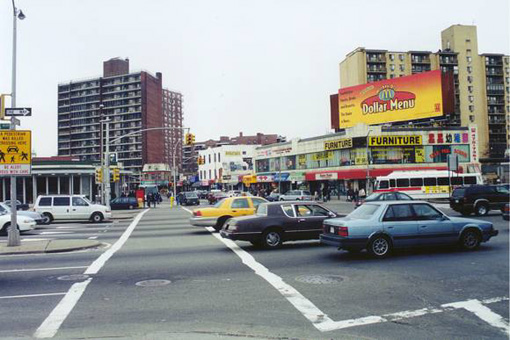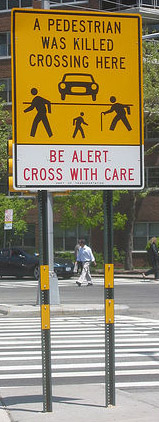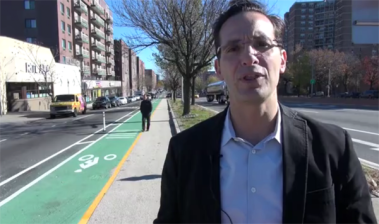The Iris Weinshall Legacy: Queens Boulevard
"What became clear to me in this discussion was that the engineers were thinking from the motorists’ viewpoint." — Iris Weinshall, New York Newsday, April 29, 2001

A long walk across Queens Blvd. at Grand Ave., Elmhurst, circa March 2001. Photo: Jeff Saltzman
Departing Department of Transportation Commissioner Iris Weinshall often cites the pedestrian safety improvements she ordered for Queens Boulevard as the greatest accomplishments of her six years in office. Before taking over DOT, the Queens Boulevard death machine was killing an average of 9 pedestrians a year, including an astounding death toll of 18 in 1997 alone. Once DOT began focusing on pedestrian safety along Queens Boulevard, the death rate fell to just over three per year. Today, crossing Queens Boulevard on foot is still a challenge but it’s a lot safer than it used to be.
 As City Hall mulls the future of its Department of Transportation, it is useful to recall the decades of pedestrian carnage on Queens Boulevard and what it took, finally, to staunch the bloodshed. Because it was Queens Boulevard where Iris Weinshall, the city’s newly appointed transportation commissioner, overruled her agency’s top traffic engineers for the first time and, in so doing, achieved what she often says is her proudest accomplishment.
As City Hall mulls the future of its Department of Transportation, it is useful to recall the decades of pedestrian carnage on Queens Boulevard and what it took, finally, to staunch the bloodshed. Because it was Queens Boulevard where Iris Weinshall, the city’s newly appointed transportation commissioner, overruled her agency’s top traffic engineers for the first time and, in so doing, achieved what she often says is her proudest accomplishment.
In late 2000, the Daily News launched a crusade to tame the "Boulevard of Death." Newsday followed suit, and the 7.1 mile long, 12 lane, monster street dominated their contest for Queens readers. The tabloids ran more than twenty-five newspaper articles spotlighting the horrible conditions, including five front pages.
Prodded by the media coverage, the city’s new DOT commissioner, a transportation policy neophyte, instructed her traffic engineers to make walking across the boulevard safer and easier. But the engineers resisted. Increasing pedestrian crossing times, they said, would would back up traffic to the Queensboro Bridge and motorists would be stuck fuming. Weinshall, frustrated by her top engineers’ apparent inability or unwillingness to trade motorist convenience for pedestrian safety, shared a candid revelation with reporters: DOT’s traffic engineers, she said, were "thinking from the motorist’s viewpoint."
The traffic engineers may have been surprised at Weinshall’s concern. "Accidents" on Queens Boulevard were nothing new. For decades the public and press didn’t seem to care. Most years the papers wrote one or two articles about pedestrian fatalities on Queens Boulevard, sometimes none. Previous DOT commissioners did pitifully little about the 4 to 18 pedestrians killed and scores terribly injured each year. Pedestrian fatalities on Queens Boulevard had always just been a fact of life — collateral damage.
But times had changed. Here came a new Transportation Commissioner under relentless media pressure. Overriding their dire warnings of traffic catastrophe, Weinshall ordered DOT’s traffic engineers to act. Within weeks, the speed limit was reduced, crossing times increased, and lighting and signage improved. Over the following months and years, traffic lanes were replaced by angle parking, fences installed to reduce jaywalking, median waiting areas built and widened, and a long term plan developed. As the changes took effect, the pedestrian casualty rate on Queens Boulevard plummeted.
The taming of the "Boulevard of Death" was the crowning moment of Iris Weinshall’s six years as New York City’s transportation commissioner. It was made possible, in part, because a new, perhaps somewhat naive, transportation commissioner was willing to overrule her agency’s top traffic engineers and force them to begin looking at one of the busiest, widest, most dangerous streets in New York City
as more than just a system for moving cars and trucks — but as a
public space — a place where people live, work and walk.
Strangely, and much to the detriment of Weinshall’s legacy, the key lessons of Queens Boulevard were quickly lost. Whether talking to a Midtown Manhattan Business Improvement District or a neighborhood group in Brooklyn, Weinshall and her borough-level subordinates often deflected requests saying, "I’m not a traffic engineer. We’ll have to get back to you on that." Despite her initial insight that DOT’s traffic engineers viewed the city from a windshield perspective, Weinshall continued to defer to them. In a near total void of Mayoral-level interest in transportation issues, during the Weinshall years DOT’s top traffic engineers became New York City’s de facto transportation planners and policymakers.
Today, the very same traffic engineers that Weinshall faced down on Queens Boulevard have as much authority as ever. In their own words, they "own" New York City’s streets. They sign-off on every proposed bike lane, speed hump, median, neckdown, sidewalk-widening and hour of car-free park. When, for example, they decide that it is time for a functional, community-friendly, two-way, neighborhood Main Street to become a one-way highway designed to speed through-traffic and "maximize capacity," that’s that. Neighborhood groups, Community Boards and elected officials can tell DOT what to do. DOT will listen. But until a DOT commissioner or mayor says otherwise, the traffic engineers call the shots.
Whomever takes over as New York City’s next DOT commissioner should take a close look at how Iris Weinshall’s achievements on Queens Boulevard were won and then ask: Whose "viewpoint" do DOT’s traffic engineers have today?
Photo: Foodgeek / Flickr
